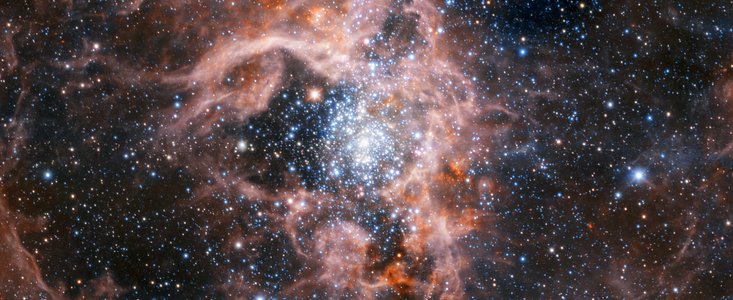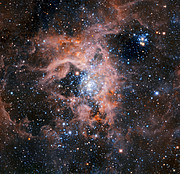Mitteilung
Schärfere Bilder für VLT-Infrarot-Kamera
Adaptive Optics Facility auf HAWK-I-Instrument erweitert
30. Januar 2018
Das Very Large Telescope (VLT) der ESO hat nun ein zweites Instrument, das mit der leistungsstarken Adaptive Optics Facility arbeitet. Das Infrarot-Instrument HAWK-I (High Acuity Wide-field K-band Imager) [1] profitiert nun ebenfalls von schärferen Bildern und kürzeren Belichtungszeiten. Dem ging eine erfolgreiche Kopplung der AOF mit MUSE voraus, dem Multi Unit Spectroscopic Explorer.
Die Adaptive Optics Facility (AOF) ist ein Langzeitprojekt am Very Large Telescope (VLT) der ESO, das sich der Vollendung nähert. Si ermöglicht Korrekturen mit Adaptiver Optik für alle Instrumente am Hauptteleskop 4 (Yepun) des VLT.
Adaptive Optik soll die verzerrenden Effekte der Erdatmosphäre kompensieren. Die Erweiterung befähigt HAWK-I jetzt zu schärferen Aufnahmen, außerdem reicht eine kürzere Belichtungszeit als zuvor aus, um ähnliche Ergebnisse zu erzielen. Durch Nutzung der AOF können Astronomen nun mit HAWK-I sogar dann eine gute Bildqualität erreichen, wenn die Wetterbedingungen nicht perfekt sind.
Nach einer Reihe von Tests mit dem neuen System wurden die Astronomen und Ingenieure vom Inbetriebnahme-Team mit zahlreichen spektakulären Bildern belohnt – darunter auch eines vom Tarantelnebel-Sternentstehungsgebiet in der Großen Magellanschen Wolke.
Die AOF, die diese Beobachtung ermöglichte, ist aus mehreren miteinander arbeitenden Teilen zusammengesetzt. Dazu gehören die Four Laser Guide Star Facility (4LGSF) und der sehr dünne, verformbare Zweitspiegel von Hauptteleskop 4, der seine Kontur verändern kann [2] [3]. Die 4LGSF lässt vier 22-Watt-Laser in den Himmel strahlen, um Natrium-Atome in der oberen Atmosphäre zum Leuchten anzuregen und auf diese Weise künstliche Leitsterne zu erzeugen.
Sensoren im Modul GRAAL (GRound layer Adaptive optics Assisted by Lasers) der Adaptiven Optik nutzen diese künstlichen Leitsterne, um die atmosphärischen Bedingungen zu ermitteln. Tausend Mal in der Sekunde berechnet das AOF-System die Korrektur, die am verformbaren Zweitspiegel des Teleskops vorzunehmen ist, um die atmosphärischen Störungen zu kompensieren.
GRAAL korrigiert Turbulenzen in der Atmosphärenschicht bis etwa 500 Meter über dem Teleskop – der „Bodenschicht“. Je nach den Bedingungen kommen atmosphärische Turbulenzen in allen Höhe vor, aber Studien haben gezeigt, dass ein großer Teil der Störungen in der Bodenschicht der Atmosphäre auftreten.
Die Korrekturen, die von der AOF eingeleitet werden, verbessern schnell und kontinuierlich die Bildqualität, indem sie das Licht bündeln, um schärfere Aufnahmen zu erzeugen. So ist es HAWK-I möglich, feinere Details aufzulösen und schwächere Sterne zu entdecken als zuvor.
MUSE und HAWK-I sind nicht die einzigen Instrumente, die von der AOF profitieren werden; in der Zukunft wird das neue Instrument ERIS am VLT installiert sein. Die AOF ist auch ein Wegbereiter für Adaptive Optik am Extremely Large Telescope der ESO, dem ELT.
Endnoten
[1] HAWK-I ist ein Wide-Field-Imager, ein Instrument, das Bilder vom Himmel im Infrarot-Wellenlängenbereich macht. Dies erlaubt es dem Instrument, in interstellaren Staub und Gase, die das optische Licht blockieren, hineinzuschauen. Das Instrument benutzt vier Bildgebungs-Chips gleichzeitig, um solch ein großes Blickfeld zu haben, und fängt damit eine Fülle an Informationen ein.
[2] Mit etwas über einem Meter Durchmesser ist dies der größte adaptiv-optische Spiegel, der im Einsatz ist, und es erforderte Spitzentechnik, um ihn herzustellen. Er wurde 2016 am Hauptteleskop 4 angebracht (ann16708), um den originalen und konventionellen Zweitspiegel des Teleskops zu ersetzen.
[3] Andere Tools zur Optimierung des AOF-Betriebs wurden entwickelt und sind nun einsatzfähig. Dazu gehört eine Erweiterung der Astronomical-Site-Monitor-Software, die die Atmosphäre beobachtet, um die Höhe zu bestimmen, auf der die Turbulenzen auftreten. Und es gehört dazu das Laser Traffic Control System (LTCS), das andere Teleskope davor bewahrt, in die Laserstrahlen oder Punkte zu schauen und so womöglich ihre eigenen Beobachtungen zu beeinträchtigen.
Links
- Technische Informationen zu GRAAL und dem verformbaren Zweitspiegel des VLT
- Veranstaltung, mit der das erste Licht der 4 Laser Guide Star Facility am VLT gefeiert wurde
- Die HAWK-I-Kamera
Kontaktinformationen
Harald Kuntschner
ESO, AOF Project Scientist
Garching bei München
Tel: +49 89 3200 6465
E-Mail: hkuntsch@eso.org
Richard Hook
ESO Public Information Officer
Garching bei München
Tel: +49 89 3200 6655
Mobill: +49 151 1537 3591
E-Mail: rhook@eso.org
Über die Mitteilung
| ID: | ann18006 |
Our use of Cookies
We use cookies that are essential for accessing our websites and using our services. We also use cookies to analyse, measure and improve our websites’ performance, to enable content sharing via social media and to display media content hosted on third-party platforms.
ESO Cookies Policy
The European Organisation for Astronomical Research in the Southern Hemisphere (ESO) is the pre-eminent intergovernmental science and technology organisation in astronomy. It carries out an ambitious programme focused on the design, construction and operation of powerful ground-based observing facilities for astronomy.
This Cookies Policy is intended to provide clarity by outlining the cookies used on the ESO public websites, their functions, the options you have for controlling them, and the ways you can contact us for additional details.
What are cookies?
Cookies are small pieces of data stored on your device by websites you visit. They serve various purposes, such as remembering login credentials and preferences and enhance your browsing experience.
Categories of cookies we use
Essential cookies (always active): These cookies are strictly necessary for the proper functioning of our website. Without these cookies, the website cannot operate correctly, and certain services, such as logging in or accessing secure areas, may not be available; because they are essential for the website’s operation, they cannot be disabled.
Functional Cookies: These cookies enhance your browsing experience by enabling additional features and personalization, such as remembering your preferences and settings. While not strictly necessary for the website to function, they improve usability and convenience; these cookies are only placed if you provide your consent.
Analytics cookies: These cookies collect information about how visitors interact with our website, such as which pages are visited most often and how users navigate the site. This data helps us improve website performance, optimize content, and enhance the user experience; these cookies are only placed if you provide your consent. We use the following analytics cookies.
Matomo Cookies:
This website uses Matomo (formerly Piwik), an open source software which enables the statistical analysis of website visits. Matomo uses cookies (text files) which are saved on your computer and which allow us to analyze how you use our website. The website user information generated by the cookies will only be saved on the servers of our IT Department. We use this information to analyze www.eso.org visits and to prepare reports on website activities. These data will not be disclosed to third parties.
On behalf of ESO, Matomo will use this information for the purpose of evaluating your use of the website, compiling reports on website activity and providing other services relating to website activity and internet usage.
Matomo cookies settings:
Additional Third-party cookies on ESO websites: some of our pages display content from external providers, e.g. YouTube.
Such third-party services are outside of ESO control and may, at any time, change their terms of service, use of cookies, etc.
YouTube: Some videos on the ESO website are embedded from ESO’s official YouTube channel. We have enabled YouTube’s privacy-enhanced mode, meaning that no cookies are set unless the user actively clicks on the video to play it. Additionally, in this mode, YouTube does not store any personally identifiable cookie data for embedded video playbacks. For more details, please refer to YouTube’s embedding videos information page.
Cookies can also be classified based on the following elements.
Regarding the domain, there are:
- First-party cookies, set by the website you are currently visiting. They are stored by the same domain that you are browsing and are used to enhance your experience on that site;
- Third-party cookies, set by a domain other than the one you are currently visiting.
As for their duration, cookies can be:
- Browser-session cookies, which are deleted when the user closes the browser;
- Stored cookies, which stay on the user's device for a predetermined period of time.
How to manage cookies
Cookie settings: You can modify your cookie choices for the ESO webpages at any time by clicking on the link Cookie settings at the bottom of any page.
In your browser: If you wish to delete cookies or instruct your browser to delete or block cookies by default, please visit the help pages of your browser:
Please be aware that if you delete or decline cookies, certain functionalities of our website may be not be available and your browsing experience may be affected.
You can set most browsers to prevent any cookies being placed on your device, but you may then have to manually adjust some preferences every time you visit a site/page. And some services and functionalities may not work properly at all (e.g. profile logging-in, shop check out).
Updates to the ESO Cookies Policy
The ESO Cookies Policy may be subject to future updates, which will be made available on this page.
Additional information
For any queries related to cookies, please contact: pdprATesoDOTorg.
As ESO public webpages are managed by our Department of Communication, your questions will be dealt with the support of the said Department.



